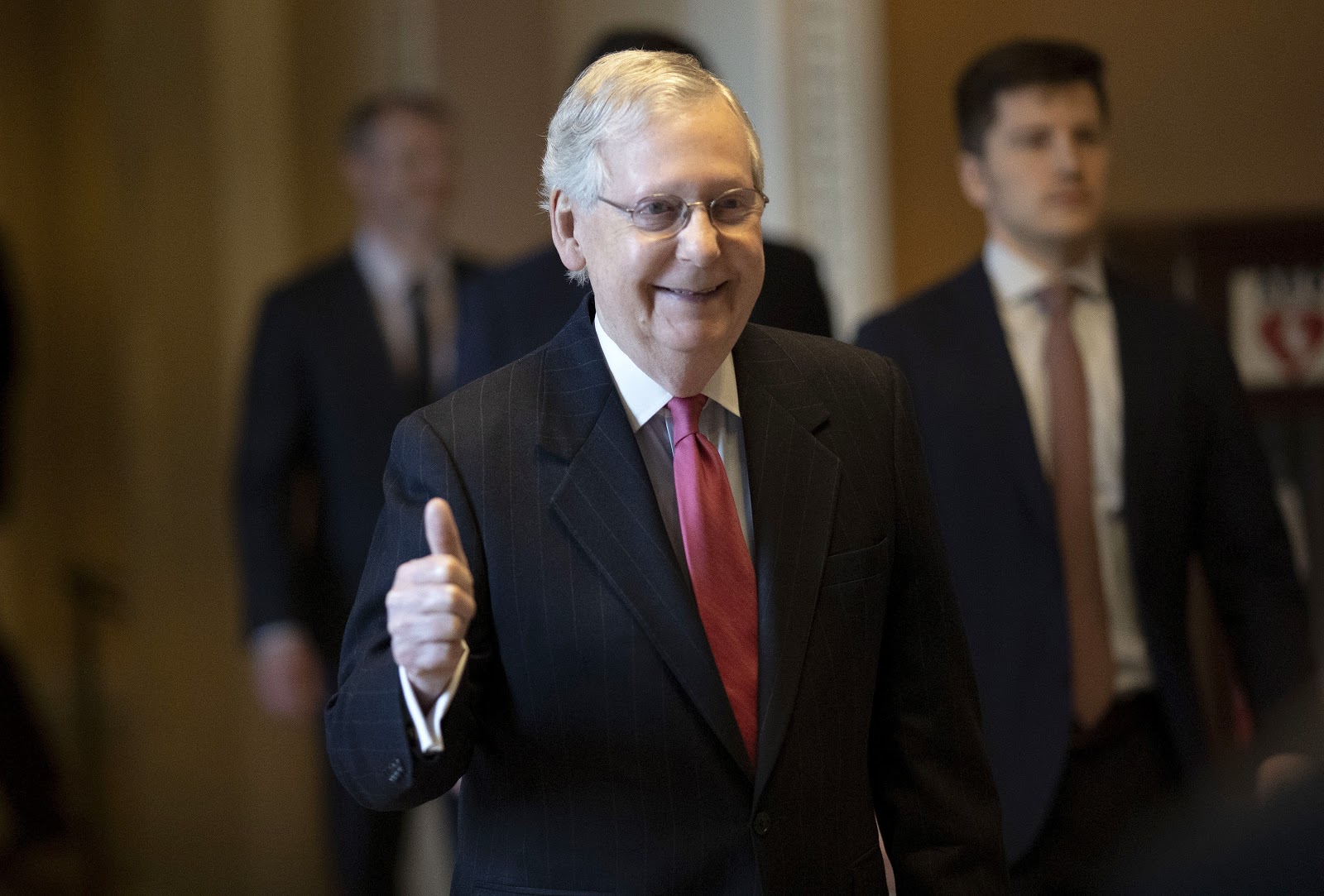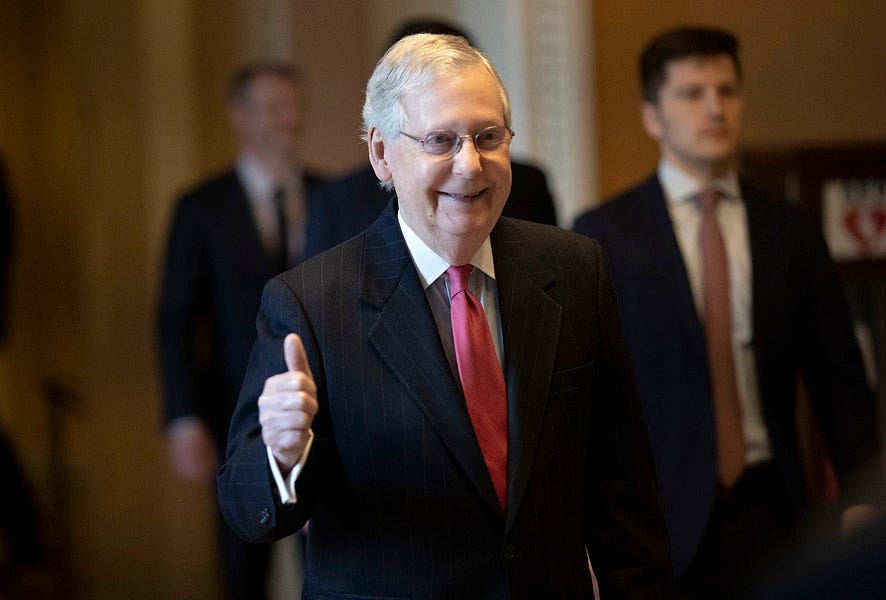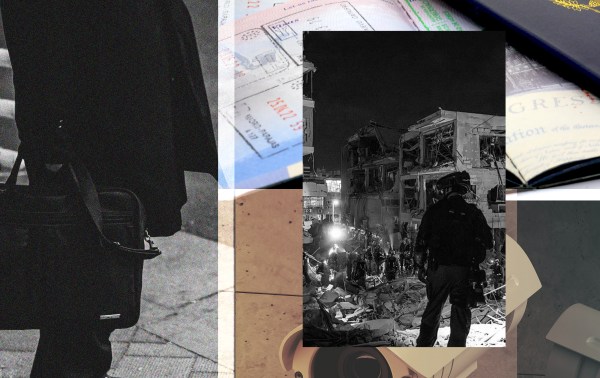Happy Thursday! Most of us are starting to feel settled in working from home by now—but beware! Let your guard down, and all sorts of teleconferencing mishaps await. Just ask Sen. Tammy Duckworth.
Quick Hits: Today’s Top Stories
-
As of Wednesday night, there are now 68,960 confirmed cases of COVID-19 in the United States (a 25 percent increase from yesterday) and 1,031 deaths (a 29 percent increase from yesterday), according to the Johns Hopkins University COVID-19 Dashboard, leading to a mortality rate among confirmed cases of 1.5 percent. About 15 percent of the 418,810 coronavirus tests conducted in the United States have come back positive, per the COVID Tracking Project, a separate dataset with slightly different top-line numbers.
-
The Senate passed, 96-0, the CARES Act, a $2 trillion bill that will provide economic relief to individuals, families, and businesses affected by the coronavirus pandemic. The House is expected to vote on the bill on Friday.
-
Robert Levinson, a retired FBI agent who went missing in Iran 13 years ago, died in Iranian custody, his family concluded based on information provided to them by U.S. officials.
A Close Call and a Unanimous Vote

In Wednesday’s Morning Dispatch, we reported that the Senate had struck a late-night handshake agreement on a $2 trillion economic aid package, and that all that remained was to hold the vote.
Ultimately, that’s exactly what happened. Shortly before midnight, the Senate voted unanimously—absent four quarantined senators—to send the bill on to the House. But everything that came before was much more chaotic than expected. For a little while Wednesday afternoon, it looked like the vote might not happen at all.
Majority Leader Mitch McConnell presented the deal to his conference on a members-only call. Shortly after, he had a minor mutiny on his hands. A knot of GOP senators, spearheaded by Sens. Ben Sasse, Lindsey Graham, and Tim Scott, objected to one of McConnell’s concessions to Senate Democrats: an additional $600-a-week boost to unemployment payouts for the next four months. The senators argued that this extra payout would create “a strong incentive for employees to be laid off instead of going to work,” which could “risk life-threatening shortages in sectors where doctors, nurses, and pharmacists are trying to care for the sick,” and introduced an amendment to limit the maximum unemployment payout to a worker’s previous paycheck.
Was it a reasonable policy objection, on the merits? It’s a complicated question. On the one hand, the senators’ math was correct: Under the provision, which Minority Leader Chuck Schumer described as “unemployment insurance on steroids,” employees pulling down $15 an hour will indeed make less weekly income than people on unemployment for the next four months. But the question of the perverse incentive is far murkier. First, it’s not like workers can just quit their jobs to make more money from unemployment: It’s only laid off workers, not quitters, who are eligible for unemployment benefits. Second, it seems unlikely that anyone with a stable job in a time of uncertainty would burn that bridge for four months of slightly juiced income. (The senators’ rejoinders: Our slammed unemployment offices aren’t likely to be checking who was laid off and who quit very carefully, and why take the chance?)
In the end, though, the merits of that nuanced question didn’t matter much compared to the brute political imperative of the day: McConnell had his handshake agreement, and after days of blistering denunciations of Democrats for stalling, he wasn’t about to reopen the floor for lengthy discussion. After a few hours’ negotiation, the holdouts agreed not to force a delay on the final vote in exchange for a vote on their amendment, which was defeated 48-48.
Other than the unemployment payouts, the broad strokes of the final bill look much the same as what GOP senators have been advocating for days. The individual cash payments still shake out as $1,200 per adult and $500 per child, beginning to phase out for persons making more than $75,000, with those making $99,000 or more receiving nothing at all. Another $349 billion will be reserved for small business loans, which will not need to be repaid when they are spent on payroll, rent, or utilities. Additionally, the Treasury Department will be authorized to dispense the $500 billion in loans and investments Republicans had sought—although, in late concessions to Democrats, loans dispensed will be announced on the Treasury website, and federal officials and their relatives will be barred from receiving funds. Hospitals and airlines will also receive more targeted infusions of cash.
The package now goes to the House, where speedy passage will face yet another challenge. Since both parties’ leadership and the White House all support the deal, its ultimate passage is all but assured. But what that vote will look like remains an open question. House Speaker Nancy Pelosi has said she hopes to adopt the measure by unanimous consent—which would not require the far-flung House members to return to Washington from their current recess. But any single member can defeat such a vote by objecting, at which point a full floor vote would become necessary. The likeliest members to make use of such a move appear to be Democratic freshman Alexandria Ocasio-Cortez and independent Justin Amash.
This Was All Predicted in 2004
Paul Miller, a professor of the practice of international affairs at Georgetown University, has a fascinating piece on the website today about the intel community and how it foresaw our current situation. It’s more than 3,000 words but let’s be honest: If you can’t find the time to read a great longform piece now, when will you? And it’s well worth the investment—trust us. Some of our biggest takeaways:
Hold up: The National Intelligence Council (NIC) predicted this whole pandemic back in 2004?
Incredibly, yes. In 2004, the NIC published a report called Mapping the Global Future—written to describe what the world could look like in 2020—that predicted the appearance of “a new pandemic … such as the 1918–1919 influenza virus that killed an estimated 20 million worldwide,” warning that it could “put a halt to global travel and trade during an extended period, prompting governments to expend enormous resources on overwhelmed health sectors.” Sound familiar?
As Miller writes, “[t]hat document is now one of the most astonishingly accurate predictions in the history of U.S. intelligence.”
What did it predict about how this would affect different parts of the globe?
As Miller writes, the NIC consistently believed that the economic fallout of a global pandemic would be worse in developing countries and the global South. In 2004 it warned that “such a pandemic in megacities of the developing world with poor health-care systems—in Sub-Saharan Africa, China, India, Bangladesh or Pakistan—would be devastating and could spread rapidly throughout the world.” In 2012, the fictional analyst commented that because of rising nationalism, “with the increased security and border controls, the U.S., some Europeans, and even China are better able to weather the pandemic,” than the developing world.
While it isn’t clear yet how true this may prove, with cases of COVID-19 appearing in Africa and across Asia, albeit more slowly, those countries’ less-well-developed healthcare systems will soon be put to the test.
After the initial fallout, how does he see this playing out on the international stage?
Miller paints a dark picture here: With multiple overlapping crises in political, economic, and environmental spheres, the planet is a powder keg. Will American nationalists blame China for the virus and ensuing recession and look for excuses to worsen the trade war? Will democratic governments fall as citizens turn to demagogues who promise drastic action to save lives, guard against foreign diseases, and restart economic life? Will Russia use Western weakness and distraction to launch another land grab in Eastern Europe? Will other governments see an opportunity to use armed conflict to rally their citizens in times of disease and poverty? Will a new political movement arise that takes the blame of elites and “globalists” to the next level, proclaiming the virus a blessing for weeding out the weak and infirm and giving the survivors the “natural” right to rule? It is relatively easy to imagine worst-case scenarios, especially since so many of them seem destined to come true.
And at home?
Here Miller sounds more hopeful. The COVID-19 outbreak, he writes, could be the catalyst for the emergence of a new political movement centered on genuine democracy, genuine opportunity, and genuine community. As President Barack Obama came into office in January 2009, a watchword of his administration was “never let a crisis go to waste.” The economy was in free fall following the bursting of the housing market bubble, the United States was engaged in wars in Iraq and Afghanistan, and Russia had just invaded Georgia. The idea was sound: times of great upheaval area also times of great opportunity. Obama’s legacy did not quite live up to the aspiration of his 2008 campaign, but the next president is likely to inherit an even larger set of crises at home and abroad. Best not to let another crisis go to waste.
Worth Your Time
-
You’ve likely heard quite a bit about the Spanish flu epidemic of 1918. In this video, David Remnick of The New Yorker interviews historian John M. Barry, author of “The Great Influenza: The Story of the Deadliest Pandemic in History,” about how the 1918 influenza compares to COVID-19.
-
When we talk about the coronavirus’s likely effects on our medical system, we tend to think of “hospital capacity” as a relatively static concept: so many beds, so many ventilators, so many medical professionals. But this Atlantic piece from emergency physician Dr. Thomas Kirsch raises an unsettling possibility: Unless America acts to protect its practitioners from the disease they’re treating, we may end up in a situation where the problem is compounded by doctors and nurses deciding the risk to their own health and that of their families is no longer worth it.
-
3M, a manufacturing company that makes respirator masks, was not prepared for the SARS epidemic of 2002. Its management decided that wouldn’t happen again, and designed protocols to ensure the company would be equipped for epidemic-level demand. Now, 3M is putting its “surge capacity” to the test and Bloomberg reports its secret weapons are working effectively enough that the company plans to make more than 1 billion masks by the end of this year.
-
In yesterday’s White House Coronavirus Task Force briefing, Dr. Deborah Birx, the Task Force’s response coordinator, shared a story about why strict adherence to social distancing is so important to her. A century ago, Birx’s grandmother caught the Spanish flu at age 11, infecting Birx’s great-grandmother, who eventually succumbed to the disease. “[My grandmother] never forgot that she was the child who was in school who innocently brought that flu home,” Birx said. This family tragedy was in no way that 11-year-old girl’s fault. But, as Birx said, “this is why we keep saying to every American, you have a role to protect each and every person that you interact with.” Click here and head to the 53-minute mark to watch her story for yourself.
Presented Without Comment
Also Presented Without Comment
Also Also Presented Without Comment
Something Fun
Scientists, it turns out, get up to all sorts of nonsense when they think only other scientists are paying attention. Which is how you end up with situations like this:
For those curious, more info can be found here.
Toeing the Company Line
-
Jonah’s latest Wodin’s Day Correspondence (??) (🔒) took us Morning Dispatchers to task over yesterday’s headline. “This isn’t a stimulus bill, it’s a life-support bill,” he writes. “It’s the difference between cocaine and oxygen, or between a shot of adrenaline and a blood transfusion.” Okay, Jonah, fine. We’ll still give you the traffic and tell our readers to click here to read the whole thing, because it’s a great piece.
-
The latest Dispatch Podcast is out! Join Sarah, Steve, Jonah, and David as they discuss the latest coronavirus developments and Joe Biden’s efforts to break through, before wrapping up with a conversation about their favorite quarantine beverages. Tune in here.
-
The relief package passed last night includes billions in loans for small businesses. But for some, even that help won’t be enough. On the website today, Aparna Mathur looks at how we could improve the Chapter 7 bankruptcy process to help entrepreneurs now more than ever.
Let Us Know
As part of the legislation the Senate approved late last night, Americans below set earning thresholds will be receiving $1,200 checks in the coming weeks. For many, this money is desperately needed to pay bills and put food on the table as the economy has ground to a halt. For those who haven’t seen their employment and earnings disrupted, the need is not as dire.
Many in the latter camp will be looking for charities and causes to which they can donate this unexpected income. What organizations could use the support?
Reporting by Declan Garvey (@declanpgarvey), Andrew Egger (@EggerDC), Alec Dent (@Alec_Dent), Sarah Isgur (@whignewtons), and Steve Hayes (@stephenfhayes).
Photograph of Mitch McConnell by Win McNamee/Getty Images.







Please note that we at The Dispatch hold ourselves, our work, and our commenters to a higher standard than other places on the internet. We welcome comments that foster genuine debate or discussion—including comments critical of us or our work—but responses that include ad hominem attacks on fellow Dispatch members or are intended to stoke fear and anger may be moderated.
With your membership, you only have the ability to comment on The Morning Dispatch articles. Consider upgrading to join the conversation everywhere.